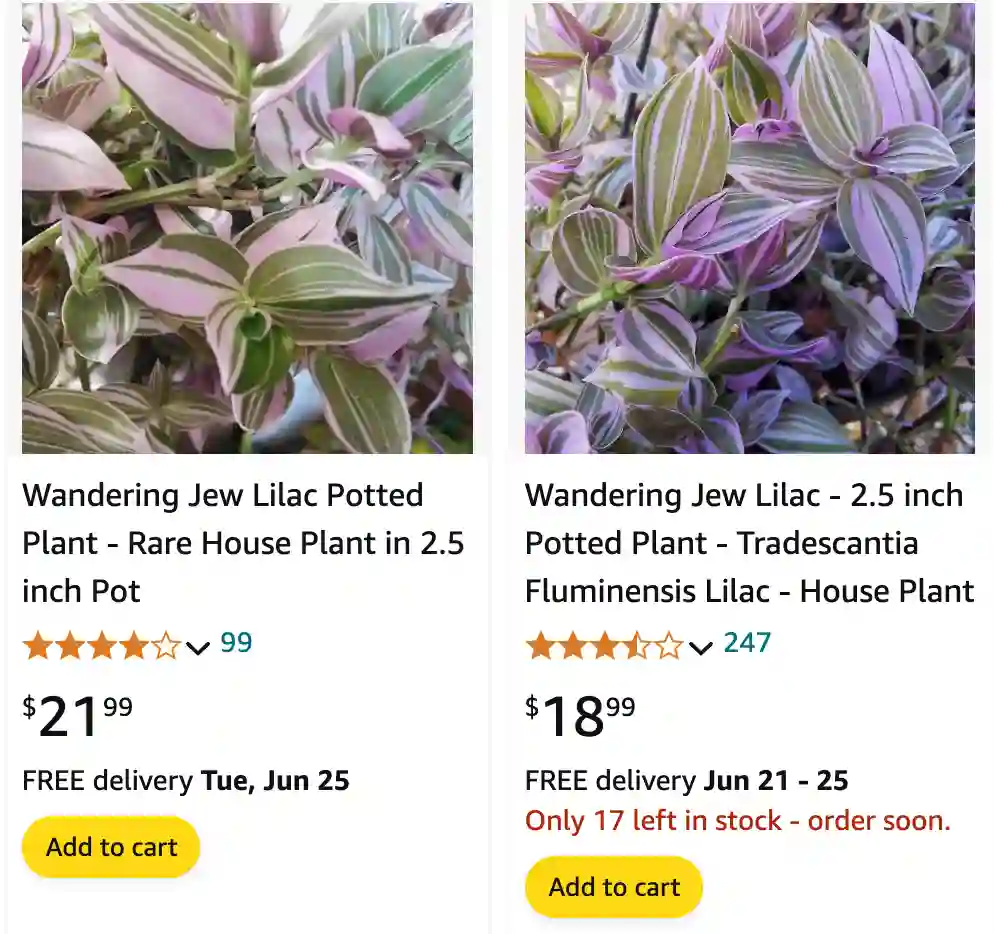
Tradescantia Lilac: Bringing a Touch of Lilac Elegance Indoors
Hi, Ferb Vu here, and I’m a huge fan of easy-care houseplants. Today, I want to introduce you to the charming Tradescantia Lilac, a stunning addition to any indoor space. This beauty boasts vibrant purple-green foliage and delicate white blooms, adding a touch of elegance to your home.
But before we delve deeper, let’s answer some of the most common questions about this captivating plant.
How to care for Tradescantia Lilac?
Light: Unveiling the Sweet Spot
Tradescantia Lilac thrives in bright, indirect light. Think of a room bathed in the gentle glow of morning sun. Direct afternoon sun can scorch the leaves, leaving unsightly brown patches. Conversely, too little light will lead to leggy growth and pale foliage.
Finding the perfect spot? Look for a window facing east or north. Alternatively, position your plant a few feet away from a south-facing window. Remember, rotate your Tradescantia Lilac regularly to ensure even growth.
Watering: Striking the Balance
Tradescantia Lilac prefers consistently moist, but not soggy, soil. Here’s the key: water deeply when the top inch of soil feels dry to the touch. Avoid overwatering, which can cause root rot – the bane of many houseplants.
A good rule of thumb? Water thoroughly until the excess drains freely from the drainage holes. Discard any water that accumulates in the saucer to prevent the roots from sitting in water.
During the cooler winter months, you can reduce watering frequency as the plant goes dormant.
Soil: The Foundation for Success
Well-draining soil is essential for a happy Tradescantia Lilac. A standard potting mix amended with perlite or pumice will do the trick. These amendments improve drainage and prevent waterlogging.
Here’s a tip: stick your finger into the soil. If it feels soggy after a few days, your mix might retain too much moisture. Consider repotting with a more aerated option.
Temperature and Humidity: Keeping it Cozy
Tradescantia Lilac thrives in average room temperatures, ranging from 65°F to 80°F (18°C to 27°C). Avoid placing it near drafty windows or heating vents.
While Tradescantia Lilac tolerates average humidity levels, it truly shines in a more humid environment. Grouping your plant with other moisture-loving plants or using a pebble tray filled with water can help increase humidity.
Fertilizer: A Gentle Nudge
Tradescantia Lilac isn’t a heavy feeder. A balanced, diluted liquid fertilizer applied once a month during the growing season (spring and summer) is sufficient. During winter, feeding can be stopped altogether.
Remember, less is always more when it comes to fertilizing houseplants. Overfertilization can lead to leaf burn and stunted growth.
How to propagate Tradescantia Lilac?
The beauty of Tradescantia Lilac is its ease of propagation. Here are two simple methods:
Stem Cuttings:
- Snip off a healthy stem with several nodes (leaf junctions).
- Remove the lower leaves and dip the stem in rooting hormone (optional).
- Plant the cutting in a pot filled with moist, well-draining potting mix.
- Keep the soil moist and provide bright, indirect light.
- Roots should develop within a few weeks.
Water Propagation:
- Fill a jar or glass with clean water.
- Take a stem cutting as described above and place it in the jar, ensuring the nodes are submerged in water.
- Change the water every few days to prevent bacteria growth.
- Tiny roots should sprout from the nodes within a couple of weeks. Once the roots are well-established, transplant the cutting into a pot with fresh potting mix.
Common Problems and Solutions: Troubleshooting Your Tradescantia Lilac
Leggy Growth and Pale Foliage: This indicates insufficient light. Move your plant to a brighter location.
Brown Leaves: This could be due to sunburn or underwatering. Check the light exposure and adjust watering frequency as needed.
Mealybugs or Aphids: These sap-sucking insects can infest your plant. Treat them with insecticidal soap or neem oil spray.
Tradescantia Lilac vs. Tradescantia Zebrina: Sorting Out the Lookalikes
Tradescantia Lilac and Tradescantia Zebrina (Wandering Jew) are often confused due to their similar trailing growth habit. However, there are key differences:
- Foliage: Tradescantia Lilac has vibrant purple-green leaves, while Tradescantia Zebrina boasts green leaves with prominent silvery stripes.
- Flowers: Both varieties produce small white flowers, but Tradescantia Lilac’s may be slightly less frequent.
Tradescantia Lilac vs Nanouk
I found that Tradescantia Lilac has a more subtle, calming beauty in my garden, while the vibrant colors of Tradescantia Nanouk never fail to catch my eye and brighten up the space.
Conclusion: Embrace the Elegance of Tradescantia Lilac
With its easy-care nature and stunning appearance, Tradescantia Lilac is a perfect choice for novice and seasoned plant enthusiasts alike. Its vibrant foliage adds a pop of color to any room, while its trailing habit makes it ideal for hanging baskets or shelves.




